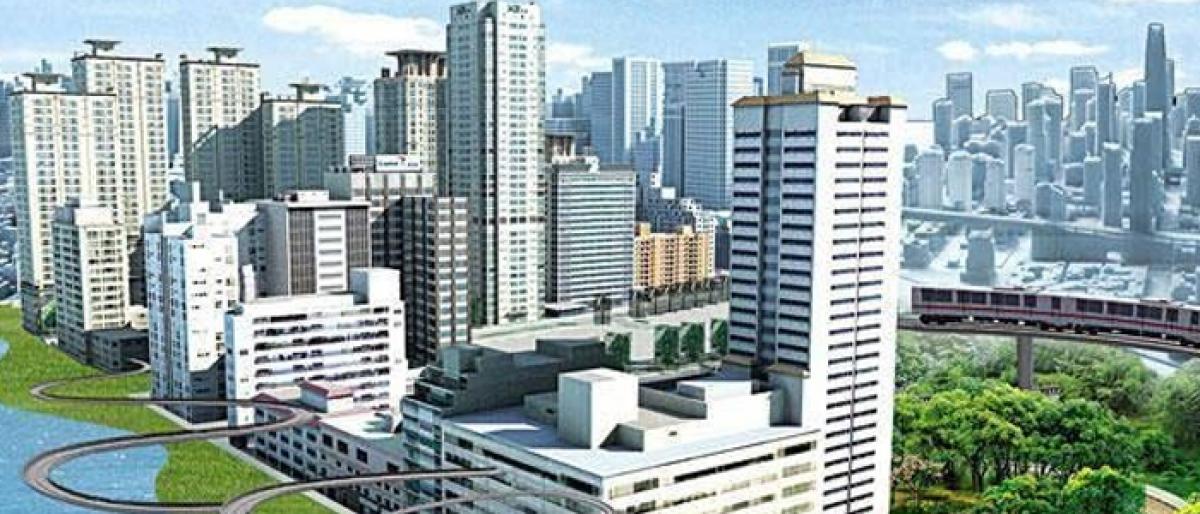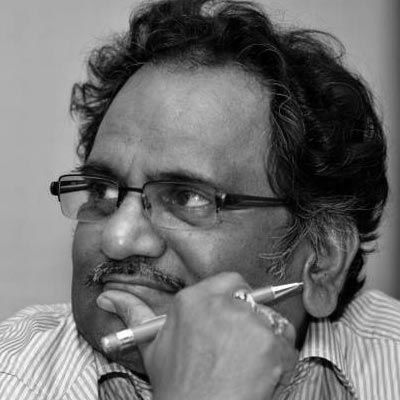Live
- 2024 on track to be hottest year on record
- PM Modi’s visit to Solapur: Women applaud ‘Double-Engine’ government’s initiatives
- Nagarkurnool MLA Dr. Kuchukulla Rajesh Reddy Campaigning in Maharashtra Elections
- Wife Kills Husband with Her Lover: Details of Veldanda Murder Case Revealed by SP Gaikwad
- Strict Action on Violations of Food Rights: Telangana Food Commission Chairman Goli Srinivas Reddy
- Smooth Conduct of Group-3 Exams with Strict Security Measures: Collector Badavath Santosh
- Delhi HC orders cancellation of LOC issued against Ashneer Grover, wife
- Shami’s absence a major blow for India in BGT, says Paul Adams
- Will organize protests at borders if attack on minority Hindus in Bangladesh not stopped: Bengal LoP
- Dutch Ambassador Marisa Gerard Meets Telangana CM A. Revanth Reddy in Delhi
Just In

The Smart City Mission does not mean development of entire city as a smart city but only a small per cent piece of area of that city. This mission for 100 cities in the country is called Area Based Development. It’s a ‘unique’ venture of development involving Union, States and a special purpose vehicle (SPV) with PPP (Private Public Partnership) model.
The Smart City Mission does not mean development of entire city as a smart city but only a small per cent piece of area of that city. This mission for 100 cities in the country is called Area Based Development. It’s a ‘unique’ venture of development involving Union, States and a special purpose vehicle (SPV) with PPP (Private Public Partnership) model.
The brains that gave birth to this scheme coined an expression ‘an urban renewal and retrofitting program’ to describe the new idea. Retrofitting means modifying existing equipment or structures with additional or new components or members. It is an engineering term used to engineer the development of an area in an elected city.
The Union Ministry took up the responsibility of implementing the mission in collaboration with the state governments of the respective cities. This development is aimed to have a rub-off effect on other parts of the city, to usher in new kind of progress.
Rub-off effect means to have an effect through close association or contact, especially so as to make similar. These cities are selected based on the Smart Cities Challenge, which means the cities will compete in a nation-wide competition to get the benefits from the scheme. By 2017, 90 cities got selected. The citizens, local government or state government have to come up with ideas of development and compete.
It is supposed to be a five-year programme, where all of the Indian states and Union territories are participating by nominating at least one city for the Smart City challenge. Financial aid is to be given by the central and the state government between 2017-2022 to the cities and the mission will start showing results from 2022 onwards.
They execute projects through joint ventures, subsidiaries, public-private partnership (PPP), turnkey contracts, etc. Center and state government will provide Rs 1,000 crore funding to the company, as equal contribution of Rs 500 crore each. The company has to raise additional funds from the financial market as a debt or equity.
This programme was launched on June 25, 2017 and a total of Rs 98,000 crore has been approved by the cabinet for development of 100 Smart Cities and rejuvenation of 500 others. Of this total amount, Rs 48,000 crore is for Smart Cities while Rs 50,000 is approved under Atal Mission for Rejuvenation and Urban Transformation (AMRUT).
In the 2014 Union Budget of India, Finance Minister Arun Jaitley allocated Rs 7,016 crore for the 150 Smart Cities. However, only Rs 924 crore could be spent out of the allocated amount until February 2015. Hence, the 2015 Union budget of India allocated only Rs 143 crore for the project. Urban Development Ministry had earlier released Rs 2 crore each to mission cities for preparation of Smart City Plans. The Central Government has taken a different approach compared to how schemes are executed previously. Earlier, the central government used to allocate money for development, and if the state governments fail to work on the projects, the money allocated will lapse.
The critical element is about citizens planning and interpreting smartness. But how that happens is not fully explained. Smart city proposals of the “winning” cities offer insights into how citizens, States and ULBs have interpreted this smartness differently.
However the Centre might stop the financing at any moment if the beneficiaries fail to take challenge, or continue their determination for change, or do not get higher mark etc. Even if a municipality or mayor does not show progress as committed in their city area development plan they will be ruthlessly replaced by another city or further finance will not be extended. That is why the West Bengal has totally withdrawn. Maharashtra has also withdrawn its Mumbai and Navi-Mumbai plan.
Visakhapatnam, Kakinada, Tirupati in Andhra Pradesh, and Warangal, Karimnagar in Telangana are selected to be smart cities. Surprisingly, the perception of the people that 90 cities are going to become smart cities under this scheme is not correct. The perception must have been generated out of confusion. A particular area of city will be earmarked for development and not the entire city.
This fact will be understood only after in-depth study of the contemplated programme. West Bengal saw this and decided not to compete. Their government declared that they would develop their cities on their own.
Then what exactly all this is? Media probed into the actual plan and came out with a conclusion that only 2.7 per cent of the cumulative area of cities identified under the initiative will be the area for development and not the entire city, for which 80 per cent of Central funding will be available.
The media report concluded that the proposed expenditure on the mission’s other component — pan-city projects, or those that cover entire cities — is only Rs 26,141 crore. Besides, the total area of these pockets covered under ABD in the 59 cities is 246 sqkm, which is just 2.7 per cent of the total area of these urban local bodies — 9,065 sq km, according to Census 2011. What kind of development is envisaged?
This refers to pockets in the selected cities that will be made ‘smart’ with a combination of IT and infrastructure projects such as WiFi hotspots, sensor-based public lighting, redesign of streets, zones promoting start-ups and multi-modal transit points. Media says the Ministry of Urban Development show that of the total Rs 1.31 lakh crore proposed to be spent on the 59 cities from 2015 to 2020, Rs 1.05 lakh crore will be spent on what is called the Area Based Development (ABD) component.
For instance: Pune ranked the second best Smart City contender and from here Prime Minister flagged off the projects in 2015, Rs 2,196 crore of the estimated Rs 2,870 crore, or 76 per cent, will be channelised into the development of a 3.6 sqkm area in the Aundh-Baner-Balewadi pocket, which comprises a little more than one per cent of the city’s 276 sqkm.
Similarly in the No.1 mission city of Bhubaneswar, 90 per cent of the Rs 4,537 crore Smart City funds are proposed to be spent on the Bhubaneswar Town Centre District, a commercial business district that accounts for less than three per cent of the city’s area. In the other three cities in the top five, Jaipur, Surat and Kochi, more than 65 per cent of the funds are proposed to be spent on ABD. Other cities such as Jabalpur, Visakhapatnam and Indore propose to spend more than 90 per cent of their funds on less than two per cent of their city area.
Centre for Internet & Society (CIS) had filed an RTI on 3 February 2016 before the Ministry of Urban Development (MoUD) regarding the Smart Cities Mission in India. The RTI sought information regarding the role of various foreign governments, private industry, multilateral bodies that will provide technical and financial assistance for this project and information on government agreements regarding PPPs for financing the project.
The Ministry would facilitate the execution of MoUs between Foreign agencies and States/UTs for assistance under this mission. The two agreements that have been executed include the MoU between the United States Trade and Development Agency (USTDA) and the French Agency for Development (AFD) for the States/UTs of Andhra Pradesh, Uttar Pradesh, Rajasthan, Maharashtra, Chandigarh and Puducherry.
They also go on to state that various countries like Spain, Canada, Germany, China, Singapore, UK and South Korea have also shown interest in collaborating with the Ministry for the development of Smart Cities. CIS sought the documents relating to role of private actors in this field. This information could not be provided by the Department since it was not available with them.
With respect to the query regarding the foreign actors involved, the information provided states that the documents relating to the involvement of the same are scattered in different files. Compilation of such information would divert the limited resources of the Public Authority disproportionately. The real information about the smart city mission has to be dug out by Right to Information applications.
(Based on my presentation in plenary session of a national convention on Smart Cities and Communications on 15 December in Visakhapatnam organised by the Public Relations Society of India)

© 2024 Hyderabad Media House Limited/The Hans India. All rights reserved. Powered by hocalwire.com







